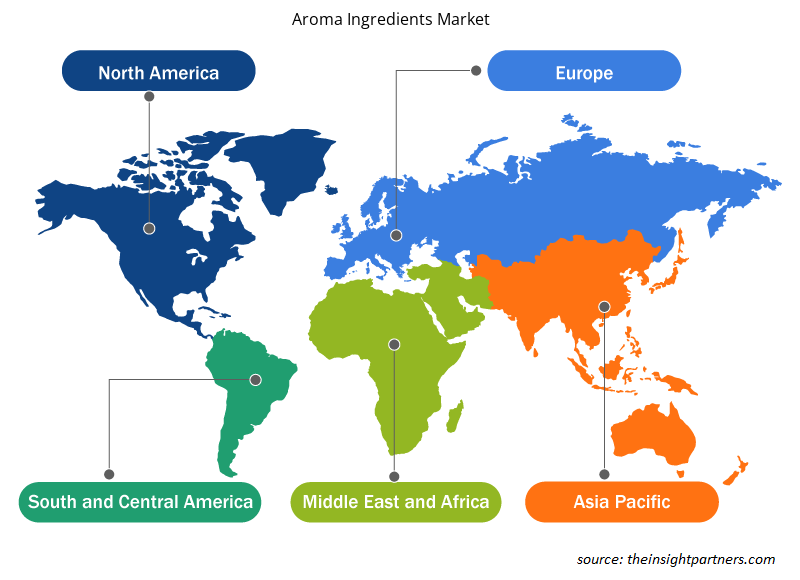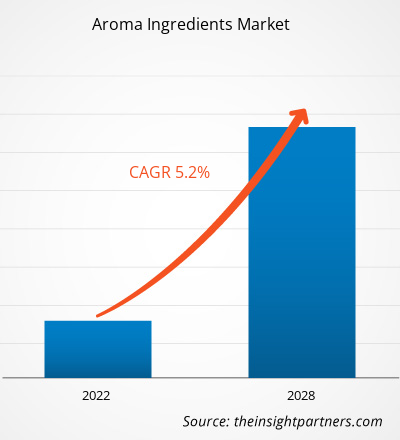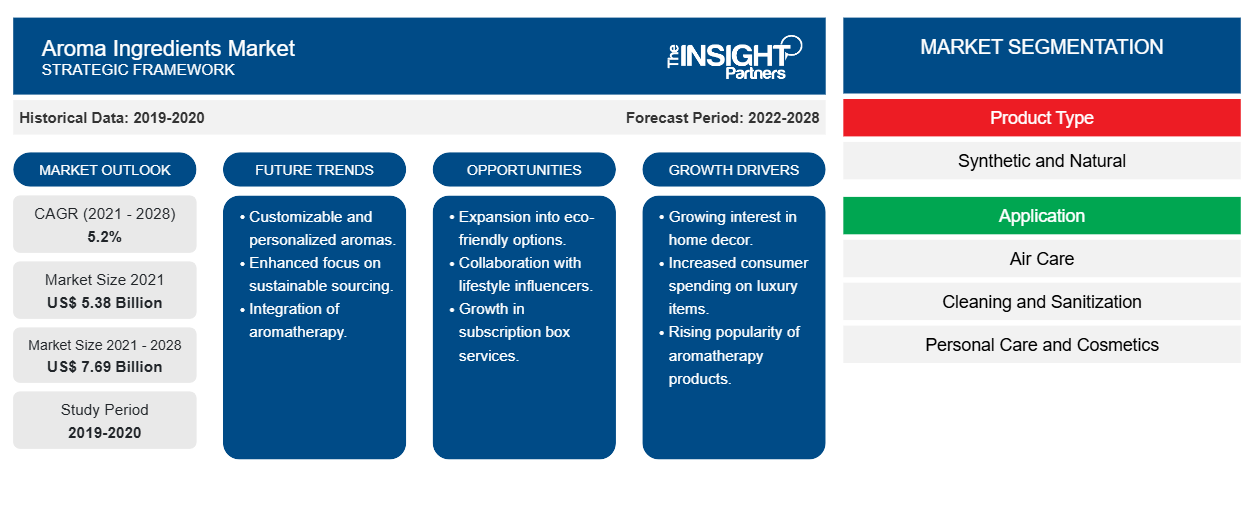Der Markt für Aromabestandteile wurde im Jahr 2021 auf 5.376,90 Millionen US-Dollar geschätzt und soll bis 2028 7.692,62 Millionen US-Dollar erreichen; es wird erwartet, dass er von 2021 bis 2028 mit einer durchschnittlichen jährlichen Wachstumsrate von 5,2 % wächst.
Aromastoffe sind im Grunde komplexe Verbindungen, die Kosmetika, Körperpflegeprodukten sowie Haushaltspflegeprodukten und anderen Produkten zugesetzt werden, um ihnen den gewünschten Duft zu verleihen. Die Aromastoffe können natürlich oder synthetisch sein. Zu den Aromastoffen zählen unter anderem ätherische Öle, Duftstoffe, Isolate, Oleoresine, Absolues, Aromachemikalien und spezielle Aromastoffe. Die sich wandelnde Körperpflege- und Kosmetikbranche hat dem Markt für Aromastoffe zahlreiche neue Wachstumschancen eröffnet und wird den Markt im Prognosezeitraum voraussichtlich ankurbeln.
Im Jahr 2020 dominierte der asiatisch-pazifische Raum den globalen Markt für Aromastoffe und wird seine Dominanz im Prognosezeitraum voraussichtlich beibehalten. In den letzten Jahren ist das Bewusstsein der Menschen im asiatisch-pazifischen Raum für ihr persönliches Erscheinungsbild gestiegen, was zu einer steigenden Nachfrage nach Kosmetikprodukten geführt hat, was wiederum zu einem Wachstum des Kosmetikmarktes in der Region geführt hat. Der Wunsch der asiatischen Verbraucher nach einem vorzeigbaren persönlichen Image hat zu einem erhöhten Bewusstsein für persönliche Hygienegewohnheiten geführt. Die wachsende Sorge der Verbraucher um ihre Gesundheit und Hygiene hat zu einer erhöhten Nachfrage nach Körperpflege-, Kosmetik- sowie Reinigungs- und Desinfektionsprodukten mit Duft- oder Aromastoffen geführt, was wiederum zu einer erhöhten Nachfrage nach Aromastoffen geführt hat. Darüber hinaus besteht der asiatisch-pazifische Raum aus Ländern wie Indien und China, die sich zu Produktionszentren für zahlreiche Endverbrauchsmärkte entwickelt haben, die Aromastoffe verwenden. Die wachsende Bevölkerung in den Entwicklungsländern des asiatisch-pazifischen Raums sowie das steigende verfügbare Einkommen haben zu einer erhöhten Nachfrage nach Körperpflege- und Kosmetikprodukten geführt. Die Nachfrage hat zu einer höheren Inlandsproduktion von Körperpflegeprodukten geführt, was zu einem erhöhten Verbrauch von Aromastoffen in der Region geführt hat.
Passen Sie diesen Bericht Ihren Anforderungen an
Sie erhalten kostenlos individuelle Anpassungen an jedem Bericht, einschließlich Teilen dieses Berichts oder einer Analyse auf Länderebene, eines Excel-Datenpakets sowie tolle Angebote und Rabatte für Start-ups und Universitäten.
-
Holen Sie sich die wichtigsten Markttrends aus diesem Bericht.Dieses KOSTENLOSE Beispiel umfasst eine Datenanalyse von Markttrends bis hin zu Schätzungen und Prognosen.
Markteinblicke
Vielfältige Anwendungsmöglichkeiten des Aromastoffs
Die zunehmende Verwendung von Aromastoffen in verschiedenen Anwendungen wie Luftpflege, feinen Düften und Parfüms, Haushaltsprodukten, Lebensmitteln und Getränken sowie Pharmazeutika führt zu einer erhöhten Nachfrage nach Aromastoffen. Feine Düfte umfassen wichtige Anwendungsbereiche wie Parfüms, Eau de Cologne, Körpersprays und Deodorants. Aromastoffe sind eines der wesentlichen Elemente, die in Formulierungen feiner Düfte verwendet werden. Darüber hinaus werden Aromastoffe in Haushaltsprodukten wie Reinigungsmitteln, Hand- und Geschirrspülmitteln, Wäschepflege- und Weichspülern, Tüchern und wässrigen Farbstoffen verwendet. Daher wird eine zunehmende Verwendung von Aromastoffen das Wachstum des Marktes für Aromastoffe vorantreiben.dishwashing liquids, laundry care and fabric softeners,
Einblicke in Produkttypen
Basierend auf dem Produkttyp ist der Markt für Aromastoffe in natürliche und synthetische unterteilt. Im Jahr 2020 war das natürliche Segment das am schnellsten wachsende Segment auf dem Markt für Aromastoffe. Die zunehmenden gesundheitlichen Bedenken im Zusammenhang mit synthetischen Chemikalien haben zu einer erhöhten Nachfrage der Verbraucher nach natürlichen Aromastoffen geführt. Die synthetischen Aromastoffe sind jedoch vergleichsweise einfacher in großem Maßstab herzustellen und behalten dabei über alle Chargen hinweg die gleiche Qualität bei. Die gleichbleibende Qualität synthetischer Inhaltsstoffe hat daher aufgrund der weit verbreiteten Verwendung insbesondere in der schnelllebigen Konsumgüterindustrie zu einem größeren Marktanteil geführt.
Takasago International Corporation; BASF SE; Firmenich SA; Givaudan SA; International Flavors & Fragrances Inc.; Robertet Group; Symrise; Mane; Zhejiang NHU Co., Ltd.; und Phoenix Aromas & Essential Oils, LLC; gehören zu den wichtigsten Akteuren auf dem Markt für Aromastoffe. Die führenden Akteure verfolgen verschiedene Strategien, wie Fusionen und Übernahmen sowie Produkteinführungen, um ihre geografische Präsenz und Kundenbasis zu erweitern. International Corporation; BASF SE; Firmenich S.A.; Givaudan S.A.; International Flavors & Fragrances Inc.; Robertet Group; Symrise; Mane; Zhejiang NHU Co., Ltd.; and Phoenix Aromas & Essential Oils, LLC; are among the key players operating in the aroma ingredients market. The leading players adopt several strategies, such as mergers & acquisitions and product launches, to expand their geographic presence and consumer base.
Regionale Einblicke in den Markt für Aromazutaten
Die regionalen Trends und Faktoren, die den Markt für Aromastoffe im Prognosezeitraum beeinflussen, wurden von den Analysten von Insight Partners ausführlich erläutert. In diesem Abschnitt werden auch die Marktsegmente und die Geografie von Aromastoffen in Nordamerika, Europa, im asiatisch-pazifischen Raum, im Nahen Osten und Afrika sowie in Süd- und Mittelamerika erörtert.

- Erhalten Sie regionale Daten zum Markt für Aromazutaten
Umfang des Marktberichts zu Aromazutaten
| Berichtsattribut | Details |
|---|---|
| Marktgröße im Jahr 2021 | 5,38 Milliarden US-Dollar |
| Marktgröße bis 2028 | 7,69 Milliarden US-Dollar |
| Globale CAGR (2021 - 2028) | 5,2 % |
| Historische Daten | 2019-2020 |
| Prognosezeitraum | 2022–2028 |
| Abgedeckte Segmente |
Nach Produkttyp
|
| Abgedeckte Regionen und Länder |
Nordamerika
|
| Marktführer und wichtige Unternehmensprofile |
|
Dichte der Marktteilnehmer für Aromazutaten: Die Auswirkungen auf die Geschäftsdynamik verstehen
Der Markt für Aromazutaten wächst rasant, angetrieben durch die steigende Nachfrage der Endverbraucher aufgrund von Faktoren wie sich entwickelnden Verbraucherpräferenzen, technologischen Fortschritten und einem größeren Bewusstsein für die Vorteile des Produkts. Mit steigender Nachfrage erweitern Unternehmen ihr Angebot, entwickeln Innovationen, um die Bedürfnisse der Verbraucher zu erfüllen, und nutzen neue Trends, was das Marktwachstum weiter ankurbelt.
Die Marktteilnehmerdichte bezieht sich auf die Verteilung von Firmen oder Unternehmen, die in einem bestimmten Markt oder einer bestimmten Branche tätig sind. Sie gibt an, wie viele Wettbewerber (Marktteilnehmer) in einem bestimmten Marktraum im Verhältnis zu seiner Größe oder seinem gesamten Marktwert präsent sind.
Die wichtigsten auf dem Markt für Aromastoffe tätigen Unternehmen sind:
- Takasago International Corporation
- BASF SE
- Firmenich SA
- Givaudan SA
- International Flavors & Fragrances Inc.
Haftungsausschluss : Die oben aufgeführten Unternehmen sind nicht in einer bestimmten Reihenfolge aufgeführt.

- Überblick über die wichtigsten Akteure auf dem Markt für Aromazutaten
Bericht-Spotlights
- Progressive Trends in der Aromastoffindustrie helfen den Akteuren bei der Entwicklung wirksamer langfristiger Strategien
- Von Unternehmen verfolgte Geschäftswachstumsstrategien zur Sicherung des Wachstums in entwickelten und sich entwickelnden Märkten
- Quantitative Analyse des globalen Marktes für Aromastoffe von 2019 bis 2028
- Schätzung der Nachfrage nach Aromastoffen in verschiedenen Branchen
- Porters Analyse zur Veranschaulichung der Wirksamkeit von in der Branche tätigen Käufern und Lieferanten bei der Vorhersage des Marktwachstums
- Aktuelle Entwicklungen zum Verständnis der Wettbewerbssituation auf dem Markt und der Nachfrage nach Aromastoffen
- Markttrends und -aussichten in Verbindung mit Faktoren, die das Wachstum des Marktes für Aromazutaten vorantreiben und bremsen
- Verständnis für die Strategien, die dem kommerziellen Interesse im Hinblick auf das Wachstum des globalen Marktes für Aromazutaten zugrunde liegen, und Unterstützung des Entscheidungsprozesses
- Marktgröße für Aromastoffe an verschiedenen Marktknoten
- Detaillierte Übersicht und Segmentierung des globalen Marktes für Aromastoffe sowie seiner Branchendynamik
- Marktgröße für Aromazutaten in verschiedenen Regionen mit vielversprechenden Wachstumschancen
Die „Globale Marktanalyse für Aromastoffe bis 2028“ ist eine spezialisierte und eingehende Studie der Chemie- und Materialindustrie mit besonderem Schwerpunkt auf der globalen Trendanalyse des Marktes für Aromastoffe. Der Bericht soll einen Überblick über den Markt mit detaillierter Marktsegmentierung bieten. Der Markt für Aromastoffe ist nach Produkttyp, Anwendung und Geografie segmentiert. Basierend auf dem Produkttyp ist der Markt in natürliche und synthetische Produkte segmentiert. Basierend auf der Anwendung ist der Markt in Luftpflege, Reinigung und Desinfektion, Körperpflege und Kosmetik, feine Düfte und Parfüms und andere segmentiert. Basierend auf der Geografie ist der Markt in fünf Hauptregionen segmentiert – Nordamerika, Europa, Asien-Pazifik, Naher Osten und Afrika sowie Süd- und Mittelamerika.
Firmenprofile
- Takasago International Corporation
- BASF SE
- Firmenich SA
- Givaudan SA
- International Flavors & Fragrances Inc.
- Robertet-Gruppe
- Symrise
- Mähne
- Zhejiang NHU Co., Ltd.
- Phoenix Aromas & Essential Oils, LLC.
- Historische Analyse (2 Jahre), Basisjahr, Prognose (7 Jahre) mit CAGR
- PEST- und SWOT-Analyse
- Marktgröße Wert/Volumen – Global, Regional, Land
- Branchen- und Wettbewerbslandschaft
- Excel-Datensatz
Aktuelle Berichte
Erfahrungsberichte
Grund zum Kauf
- Fundierte Entscheidungsfindung
- Marktdynamik verstehen
- Wettbewerbsanalyse
- Kundeneinblicke
- Marktprognosen
- Risikominimierung
- Strategische Planung
- Investitionsbegründung
- Identifizierung neuer Märkte
- Verbesserung von Marketingstrategien
- Steigerung der Betriebseffizienz
- Anpassung an regulatorische Trends























 Kostenlose Probe anfordern für - Markt für Aromazutaten
Kostenlose Probe anfordern für - Markt für Aromazutaten